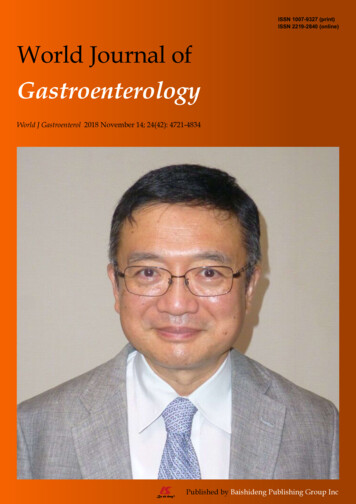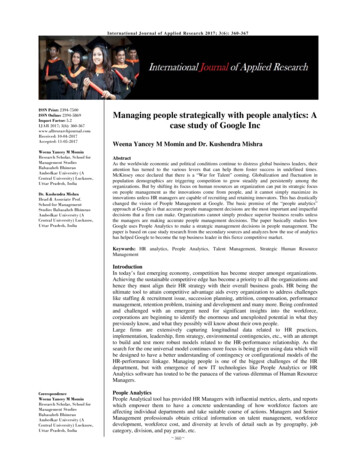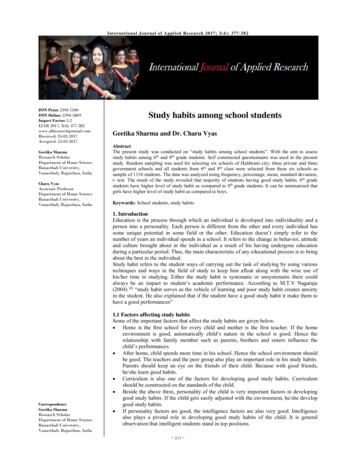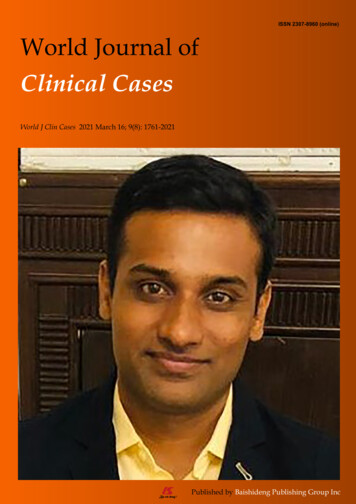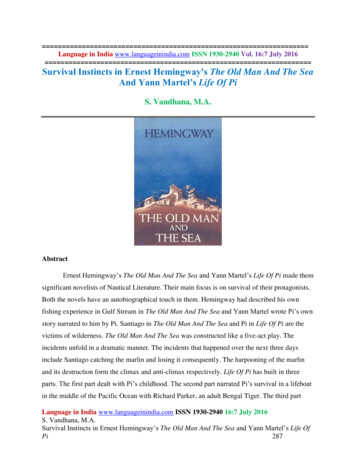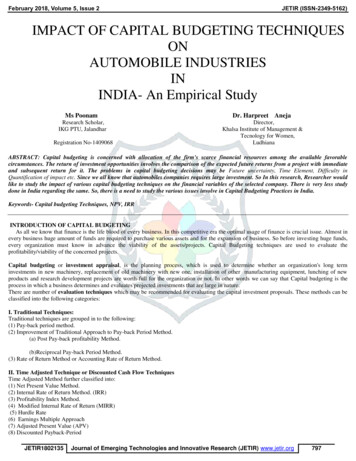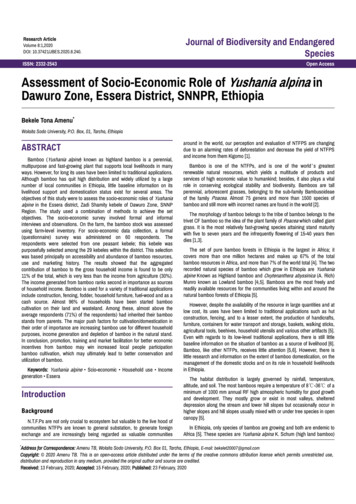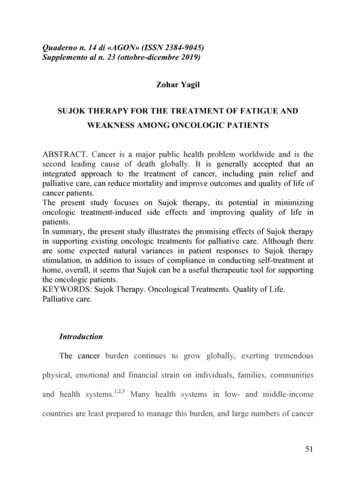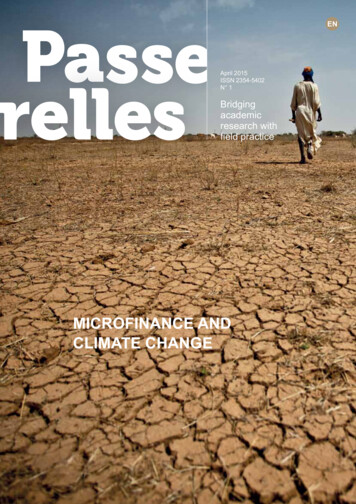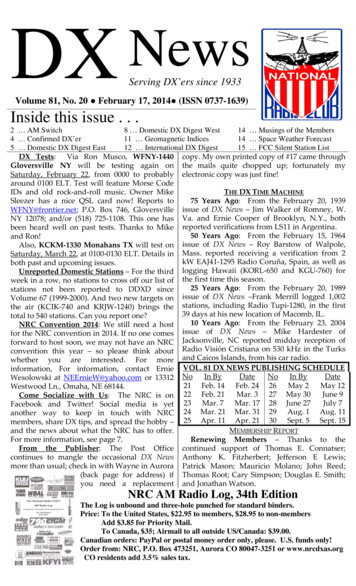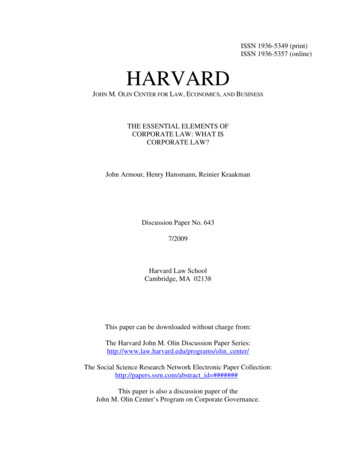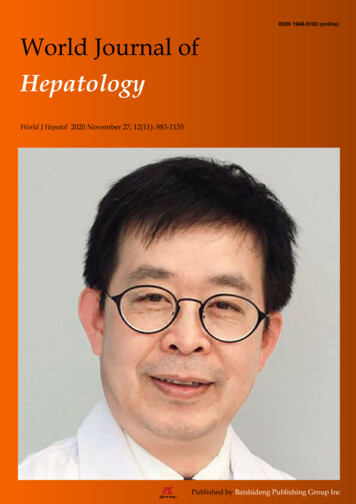
Transcription
ISSN 1948-5182 (online)World Journal ofHepatologyWorld J Hepatol 2020 November 27; 12(11): 883-1135Published by Baishideng Publishing Group Inc
WJ HWorld Journal ofHepatologyContentsMonthly Volume 12 Number 11 November 27, 2020REVIEW883Malnutrition in cirrhosis: More food for thoughtChapman B, Sinclair M, Gow PJ, Testro AGMINIREVIEWS897Paraneoplastic syndromes in cholangiocarcinomaRahman SU, Sana MK, Tahir Z, Ali A, Shah PA908Noninvasive scores for the prediction of esophageal varices and risk stratification in patients with cirrhosisBangaru S, Benhammou JN, Tabibian JH919Natremia and liver transplantation: The right amount of salt for a good recipeLenci I, Milana M, Grassi G, Signorello A, Aglitti A, Baiocchi LORIGINAL ARTICLEBasic Study931Inhibition of vascular adhesion protein-1 modifies hepatic steatosis in vitro and in vivoShepherd EL, Karim S, Newsome PN, Lalor PF949Aceclofenac-induced hepatotoxicity: An ameliorative effect of Terminalia bellirica fruit and ellagic acidGupta A, Pandey A965Obeticholic acid attenuates human immunodeficiency virus/alcohol metabolism-induced pro-fibroticactivation in liver cellsNew-Aaron M, Ganesan M, Dagur RS, Kharbanda KK, Poluektova LY, Osna NA976Screening and identification of bioactive compounds from citrus against non-structural protein 3 proteaseof hepatitis C virus genotype 3a by fluorescence resonance energy transfer assay and mass spectrometryKhan M, Rauf W, Habib F, Rahman M, Iqbal MRetrospective Cohort Study993Cannabis use history is associated with increased prevalence of ascites among patients with nonalcoholicfatty liver disease: A nationwide analysisChoi CJ, Weiss SH, Nasir UM, Pyrsopoulos NT1004Phase angle and non-alcoholic fatty liver disease before and after bariatric surgeryTeixeira J, Marroni CA, Zubiaurre PR, Henz A, Faina L, Pinheiro LK, Mottin CC, Fernandes SAWJHhttps://www.wjgnet.comINovember 27, 2020Volume 12Issue 11
World Journal of HepatologyContentsMonthly Volume 12 Number 11 November 27, 2020Retrospective Study1020Factors associated with 5-year survival of combined hepatocellular and cholangiocarcinomaSempokuya T, Wien EA, Pattison RJ, Ma J, Wong LL1031Circulating miR-21-5p level has limited prognostic value in patients with hepatocellular carcinoma and isinfluenced by renal functionFranck M, Thon C, Schütte K, Malfertheiner P, Link A1046Real impact of tumor marker AFP and PIVKA-II in detecting very small hepatocellular carcinoma ( 2 cm,Barcelona stage 0) - assessment with large number of casesTarao K, Nozaki A, Komatsu H, Komatsu T, Taguri M, Tanaka K, Chuma M, Numata K, Maeda S1055Non-invasive splenic parameters of portal hypertension: Assessment and utilityAhmad AK, Atzori S, Maurice J, Taylor-Robinson SD, Lim AKP1067Outcome of gastric antral vascular ectasia and related anemia after orthotopic liver transplantationEmhmed Ali S, Benrajab KM, Dela Cruz ACClinical Trials Study1076Hepatitis B surface antigen and hepatitis B core-related antigen kinetics after adding pegylated-interferonto nucleos(t)ids analogues in hepatitis B e antigen-negative patientsBroquetas T, Garcia-Retortillo M, Micó M, Canillas L, Puigvehí M, Cañete N, Coll S, Viu A, Hernandez JJ, Bessa X,Carrión JAObservational Study1089Occurrence of seeding metastases in resectable perihilar cholangiocarcinoma and the role of low-doseradiotherapy to prevent thisFranken LC, Roos E, Saris J, van Hooft JE, van Delden OM, Verheij J, Erdmann JI, Besselink MG, Busch OR, vanTienhoven G, van Gulik TMRandomized Controlled Trial1098Metalloproteinase expression after desflurane preconditioning in hepatectomies: A randomized clinicaltrialKoraki E, Mantzoros I, Chatzakis C, Gkiouliava A, Cheva A, Lavrentieva A, Sifaki F, Argiriadou H, Kesisoglou I, GalanosDemiris K, Bitsianis S, Tsalis KSYSTEMATIC REVIEWS1115Clinical utility of viscoelastic testing in chronic liver disease: A systematic reviewWei H, Child LJCASE REPORT1128Hepatocellular carcinoma with tumor thrombus extends to the right atrium and portal vein: A case reportGomez-Puerto D, Mirallas O, Vidal-González J, Vargas VWJHhttps://www.wjgnet.comIINovember 27, 2020Volume 12Issue 11
World Journal of HepatologyContentsMonthly Volume 12 Number 11 November 27, 2020ABOUT COVERAssociate editor of World Journal of Hepatology, Dr. Yong-Ping Yang is a Distinguished Professor at PekingUniversity Health Science Center in Beijing, China. Having received his Bachelor’s degree from Yanbian Universityin 1985, Dr. Yang undertook his postgraduate training at PLA Medical College, receiving his Master’s degree in1992. He rose to Chief Physician in the Hepatology Division of the Fifth Medical Center of the Chinese PLAGeneral Hospital in 2003 and has held the position since. His ongoing research interests involve liver fibrosis,cirrhosis and hepatocellular carcinoma, with a particular focus on cryoablation and cryo-immunotherapy forhepatocellular carcinoma. Currently, he serves as Chairman of the Department of Liver Disease of the Chinese PLAGeneral Hospital and as President of the Chinese Research Hospital Association for the Study of the Liver Disease.(L-Editor: Filipodia)AIMS AND SCOPEThe primary aim of World Journal of Hepatology (WJH, World J Hepatol) is to provide scholars and readers fromvarious fields of hepatology with a platform to publish high-quality basic and clinical research articles andcommunicate their research findings online.WJH mainly publishes articles reporting research results and findings obtained in the field of hepatology andcovering a wide range of topics including chronic cholestatic liver diseases, cirrhosis and its complications, clinicalalcoholic liver disease, drug induced liver disease autoimmune, fatty liver disease, genetic and pediatric liverdiseases, hepatocellular carcinoma, hepatic stellate cells and fibrosis, liver immunology, liver regeneration, hepaticsurgery, liver transplantation, biliary tract pathophysiology, non-invasive markers of liver fibrosis, viral hepatitis.INDEXING/ABSTRACTINGThe WJH is now abstracted and indexed in PubMed, PubMed Central, Emerging Sources Citation Index (Web ofScience), Scopus, China National Knowledge Infrastructure (CNKI), China Science and Technology JournalDatabase (CSTJ), and Superstar Journals Database.RESPONSIBLE EDITORS FOR THIS ISSUEProduction Editor: Li-Li Wang; Production Department Director: Yun-Xiaojian Wu; Editorial Office Director: Jia-Ping Yan.NAME OF JOURNALINSTRUCTIONS TO AUTHORSWorld Journal of SNGUIDELINES FOR ETHICS DOCUMENTSISSN 1948-5182 CH DATEGUIDELINES FOR NON-NATIVE SPEAKERS OF ENGLISHOctober 31, YPUBLICATION 8EDITORS-IN-CHIEFPUBLICATION MISCONDUCTNikolaos Pyrsopoulos, Ke-Qin Hu, Koo Jeong L BOARD MEMBERSARTICLE PROCESSING CATION DATESTEPS FOR SUBMITTING MANUSCRIPTSNovember 27, TONLINE SUBMISSION 2020 Baishideng Publishing Group Inchttps://www.f6publishing.com 2020 Baishideng Publishing Group Inc. All rights reserved. 7041 Koll Center Parkway, Suite 160, Pleasanton, CA 94566, USAE-mail: bpgoffice@wjgnet.com November 27, 2020Volume 12Issue 11
WJ HWorld Journal ofHepatologySubmit a Manuscript: https://www.f6publishing.comWorld J Hepatol 2020 November 27; 12(11): 1055-1066DOI: 10.4254/wjh.v12.i11.1055ISSN 1948-5182 (online)ORIGINAL ARTICLERetrospective StudyNon-invasive splenic parameters of portal hypertension:Assessment and utilityAyesha Karim Ahmad, Sebastiana Atzori, James Maurice, Simon D Taylor-Robinson, Adrian KP LimORCID number: Ayesha KarimAhmad 0000-0003-3763-1212;Sebastiana Atzori 0000-0002-4444205X; James Maurice 0000-00031530-5328; Simon D Taylor-Robinson0000-0002-8811-1834; Adrian KPLim 0000-0003-3904-2876.Author contributions: Ahmad AKcollected data, performed statisticalanalyses, wrote the manuscriptwith support from other authors;Atzori S performed theexperiments and statisticalanalyses; Maurice J criticallyappraised study design; TaylorRobinson SD and Lim AKPdesigned, supervised andimplemented the research; allauthors discussed the results andcontributed to the final manuscript.Institutional review boardstatement: This study wasperformed in accordance with the1975 Declaration of Helsinki, withapprovals from the Research EthicsCommittee and the Joint Researchand Compliance Office of ImperialCollege London and ImperialCollege Healthcare NHS Trust.Informed consent statement:Patients were required to giveinformed consent to the study inthe form of written consent.Conflict-of-interest statement: Thiswork was supported by PhilipsWJHAyesha Karim Ahmad, Liver Unit, Department of Digestion, Metabolism & Reproduction,Faculty of Medicine, Imperial College London, London W2 1NY, United KingdomSebastiana Atzori, James Maurice, Simon D Taylor-Robinson, Liver Unit, Department ofDigestion, Metabolism & Reproduction, Imperial College London, London W2 1NY, UnitedKingdomAdrian KP Lim, Liver Unit and Imaging, Department of Digestion, Metabolism & Reproduction,Imperial College London, London W2 1NY, United KingdomCorresponding author: Adrian KP Lim, MD FRCR, Doctor, Liver Unit and Imaging,Department of Digestion, Metabolism & Reproduction, Imperial College London, London W21NY, United Kingdom. a.lim@imperial.ac.ukAbstractBACKGROUNDPortal hypertension is a major complication of cirrhosis that is associated withsignificant morbidity and mortality. The present gold-standard method to riskstratify and observe cirrhosis patients with portal hypertension is hepatic venouspressure gradient measurement or esophagogastroduodenoscopy. However,these methods are invasive, carry a risk of complications and are associated withsignificant patient discomfort. Therefore, non-invasive splenic parameters are ofclinical interest as potential useful markers in determining the presence of portalhypertension. However, diagnostic accuracy and reproducibility remainsunvalidated.AIMTo assess the diagnostic accuracy of spleen stiffness, area and diameter inpredicting the presence of portal hypertension.METHODSOf 50 patients with varying liver disease pathologies were prospectively recruitedfrom the St. Mary’s Hospital Liver Unit in London; 25 with evidence of portalhypertension and 25 with no evidence of portal hypertension. Liver stiffness,spleen stiffness, spleen diameter and spleen area were measured using the PhilipsAffiniti 70 elastography point quantification point shear wave elastographysystem. The aspartate aminotransferase-to-platelet-ratio-index (APRI) score wasalso calculated. Performance measures, univariate and multivariate logistichttps://www.wjgnet.com1055November 27, 2020Volume 12Issue 11
Ahmad AK et al. Non-invasive splenic parameters of portal hypertensionMedical Systems (Seattle,Washington, United States); UnitedKingdom National Institute forHealth Research BiomedicalFacility at Imperial CollegeLondon, London, United Kingdom.Open-Access: This article is anopen-access article that wasselected by an in-house editor andfully peer-reviewed by externalreviewers. It is distributed inaccordance with the CreativeCommons AttributionNonCommercial (CC BY-NC 4.0)license, which permits others todistribute, remix, adapt, buildupon this work non-commercially,and license their derivative workson different terms, provided theoriginal work is properly cited andthe use is non-commercial. See: ession were used to evaluate demographic, clinical and elastographyvariables. Interclass correlation coefficient was used to determine thereproducibility of splenic area and diameter.RESULTSOn univariate and individual performance, platelet count [area under the receiveroperating characteristic (AUROC) 0.846, P value 0.001], spleen area (AUROC0.828, P value 0.002) and APRI score (AUROC 0.827, P value 0.001) were themost accurate variables in identifying the presence of portal hypertension. Onmultivariate logistic regression models constructed, the combination of spleenarea greater than 57.90 cm2 and platelet count less than 126 109 had 63.2%sensitivity and 100% specificity, 100% positive predictive value and 100% negativepredictive value. An alternative combination of spleen stiffness greater than 29.99kPa and platelet count less than 126 109 had 88% sensitivity, 75% specificity,78.6% positive predictive value and 85.7% negative predictive value. An interclasscorrelation coefficient value of 0.98 (95%CI: 0.94-0.99, P value 0.001) and 0.96(95%CI: 0.91-0.99, P value 0.001) were determined for inter-operator variabilityfor spleen area and diameter respectively.CONCLUSIONSpleen area, spleen stiffness and platelet count may be useful markers to assessthe presence of portal hypertension in patients of various etiologies.Key Words: Portal hypertension; Esophageal varices; Point shear wave elastography;Spleen stiffness; Spleen area; Non-invasiveManuscript source: Unsolicited The Author(s) 2020. Published by Baishideng Publishing Group Inc. All rights reserved.manuscriptSpecialty type: Gastroenterologyand hepatologyCountry/Territory of origin: UnitedKingdomPeer-review report’s scientificquality classificationGrade A (Excellent): 0Grade B (Very good): BGrade C (Good): 0Grade D (Fair): 0Grade E (Poor): 0Received: July 16, 2020Peer-review started: July 16, 2020First decision: August 9, 2020Revised: August 22, 2020Accepted: October 9, 2020Article in press: October 9, 2020Published online: November 27,2020P-Reviewer: Giuffrè MS-Editor: Fan JRL-Editor: AP-Editor: Wang LYTWJHCore Tip: Non-invasive splenic parameters are useful surrogate markers of portalhypertension (PH). A combination of spleen diameter, spleen area, liver stiffness andaspartate aminotransferase-to-platelet-ratio-index (APRI) score is able to predict thepresence of PH. The APRI score has a similar diagnostic accuracy to combinationindex.Citation: Ahmad AK, Atzori S, Maurice J, Taylor-Robinson SD, Lim AKP. Non-invasivesplenic parameters of portal hypertension: Assessment and utility. World J Hepatol 2020;12(11): 1055-1066URL: .htmDOI: CTIONPortal hypertension (PH) is a major complication of cirrhosis[1]. Esophageal varices(EV) are present in 40% of compensated advanced chronic liver disease (cACLD)patients and in 70% of decompensated cirrhosis patients. Strategies to identifyindividuals with clinically significant portal hypertension (CSPH) is vital to reducemorbidity and mortality[2].The hepatic venous pressure gradient measurement (HVPG) and esophagogastroduodenoscopy (EGD) form the backbone of diagnosis and surveillance of EV[3].However, both methods are invasive and carry a risk of complications[1]. Therefore,non-invasive and safe methods of diagnosis and surveillance of PH are of great clinicalinterest.Current guidelines propose that non-invasive methods of assessment of liverfibrosis can predict the incidence of cirrhosis-induced PH manifestations[4]. The BavenoVI guidelines suggest cirrhosis patients with a liver stiffness measurement 20 kPaand a platelet count 150000/μL can avoid screening endoscopy[3]. Nevertheless,while 20% of EGDs are spared, new algorithms are still required, as up to 40% of EGDscontinue unnecessarily[5].Ultrasound elastography techniques are based on the principle that tissue elastichttps://www.wjgnet.com1056November 27, 2020Volume 12Issue 11
Ahmad AK et al. Non-invasive splenic parameters of portal hypertensionproperties can be distorted using shear waves to measure stiffness. Spleen stiffnessmeasurements using ultrasound elastography have shown an association with CSPHas the spleen undergoes parenchymal remodelling and fibrogenesis, due to bloodpooling in PH[5-7]. Interestingly, evidence on patients with chronic hepatitis C infectionalso suggests that spleen stiffness is dependent on inflammation present in the liverthat directly contributes to the pathogenic mechanisms underlying PH[8,9].Transient elastography (TE) is the most validated ultrasound elastographytechnique and shows a sensitivity 90% in detecting patients with CSPH[6,10].Nevertheless, limitations exist due to its lack of 2D imaging guidance and attenuationof wave propagation in obesity and ascites[7].Point shear wave elastography (p-SWE), often referred to as acoustic radiation forceimpulse, overcomes these issues by providing integrated 2D-ultrasound imagingwhich can be used in patients who are obese or have ascites[7]. Despite several metaanalyses on spleen stiffness measurements, it remains unclear whether TE or p-SWEhas greater diagnostic accuracy[11,12]. Furthermore, although it is well established thatspleen stiffness and combination variables such as liver stiffness-spleen diameter toplatelet ratio (LSPS) score are superior to liver stiffness for detection of EV[13], little isknown whether a combination of splenic parameters can improve diagnosticaccuracy[14]. Finally, although two main p-SWE techniques exist–the elastography pointquantification (ElastPQ ) and Virtual Touch Quantification (VTQ )–fewer studies havelooked at the performance of ElastPQ due to its novelty.We aimed to assess whether spleen stiffness measurement, spleen area and spleendiameter can independently predict CSPH, or in combination with other biochemicalor elastography parameters; and assess reproducibility of splenic area and diametermeasurements.MATERIALS AND METHODSStudy designPatients with varying liver disease etiology were prospectively recruited as part of anongoing comparative imaging study (REC: 15/EE/0420). All subjects had evidence ofchronic liver disease (CLD), were over the age of 18 and provided informed consent.Exclusion criteria included pregnancy, lack of liver disease pathology, transjugularportosystemic shunt (TIPSS) insertion or presence of hepatocellular carcinoma (HCC).The primary analyses were conducted after all patients were recruited. The patientswere divided into the following groups: Evidence of CSPH (group 1) and no evidenceof CSPH (group 2). CSPH was defined either as presence of EV or portal hypertensivegastropathy (PHG) during an EGD or if patients had invasive procedures where theHVPG pressure 10 mmHg. Ultrasound elastography measurements must have beenundertaken within a maximum of one year of EGD or HVPG measurements.Ultrasound and elastographyAll patients had to be fasted for up to 6h prior to scans. Participants were placedsupine with arms abducted away from the ultrasound probes. The Philips Affiniti 70(ElastPQ) (Philips Medical Systems, Seattle, WA, United States) was used to recordliver stiffness measurement and spleen stiffness measurement for each patient. Tenmeasurements were taken from the liver and ten measurements from the spleen. Liverelastography measurements were taken from the right lobe of the liver 2.4 cm ( 1 cm)from the liver capsule. Spleen elastography measurements were taken from the middleaspect of the spleen with homogeneous elasticity with the exclusion of big vessels. Themedian stiffness and IQR values were recorded. Spleen area and diameter werecalculated from 2D images obtained.Clinical and biological parameters including body mass index (BMI), skin to livercapsule distance, aspartate aminotransferase (AST), alanine aminotransferase (ALT), γglutamyl transpeptidase (GGT), alkaline phosphatase (ALP), platelet count,prothrombin time, albumin, bilirubin and international normalized ratio (INR) wereobtained for all patients at time of recruitment. APRI score was calculated as: AST(IU/L)/PLT ( 109/L)[15]. Parameters determining presence of PH such as HVPGmeasurements or EGD findings were
Washington, United States); United Kingdom National Institute for Health Research Biomedical Facility at Imperial College London, London, United Kingdom. Open-Access: This article is an open-access article that was selected by an in-house editor and fully peer-reviewed by external rev
